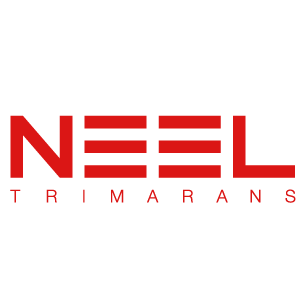
NEEL-TRIMARANS
Design and performance
NEEL trimarans are unique sailing boats that brilliantly combine unequalled comfort on board and incredible sailing pleasure. A good balance due to the experience, know-how and skills of a eam of passionate people.
Why a Trimaran
Safety
A trimaran is much more stable than a catamaran
The width of NEEL trimarans is an important factor for safety on the high seas because it is a guarantee of stability.
On a catamaran the maximum righting moment occurs at 12° heeling, as shown on the stability curve. This angle can be reached relatively easily when sailing in strong winds and heavy seas.
However, on a trimaran, this maximum righting moment does not occur until 32° heeling, therefore in normal multihull conditions of use, this angle is never reached.
For this reason, and thanks to the centered weight distribution, a trimaran is much more stable than a catamaran. Weight being centered in the main hull’s technical compartment limits pitching and results in increased boat stability and therefore safety.
This also enhances handling performance and comfort in big seas. On the other hand, catamarans have no choice but to distribute the weights (engines, batteries, generator, tanks) on the ends of their two hulls.
The PVC foam sandwich construction and collision bulkheads guarantee that the craft is unsinkable
The fin of the central hull protects the engine block and rudder gear. The shallow draft allows you to navigate close to the shore and enjoy the most beautiful anchorages. The high average speed optimises navigation planning, according to weather conditions. The fractional rig (mainsail, solent, staysail) facilitates short-handed operation, notably for duo crews. All embedded systems, such as refrigeration, electrical and electronic installations, energy generation and storage, fittings and rigging all benefit from our twenty seven years of experience in boat building.
NEEL trimarans are certified according to CE European standards by the French Institute for Nautical Certification and Standardisation (ICCN).
A trimaran offers better seakeeping:
Let’s consider both the trimaran and the catamaran heeling by 12°, which is the safety angle not to be exceeded on a catamaran. As shown in the graphics, the Righting moment (GZ) is much higher on the catamaran than on the trimaran. A high GZ means more brutal and uncomfortable seakeeping.
At this angle of heel the catamaran’s GZ is double that of the trimaran.
Therefore, sailing the trimaran is much smoother than sailing the catamaran.
The trimaran has less roll motion than the catamaran, as the center of buoyancy is never far downwind like on a catamaran. Again, centered weight is the key to success and comfort.
In fact, all significant heavy equipment is located in the main central hull on a trimaran whereas it is distributed half and half in each hull on a catamaran.
This superiority of the trimaran is even more significant in heavy seas as shown on the illustration here-below.
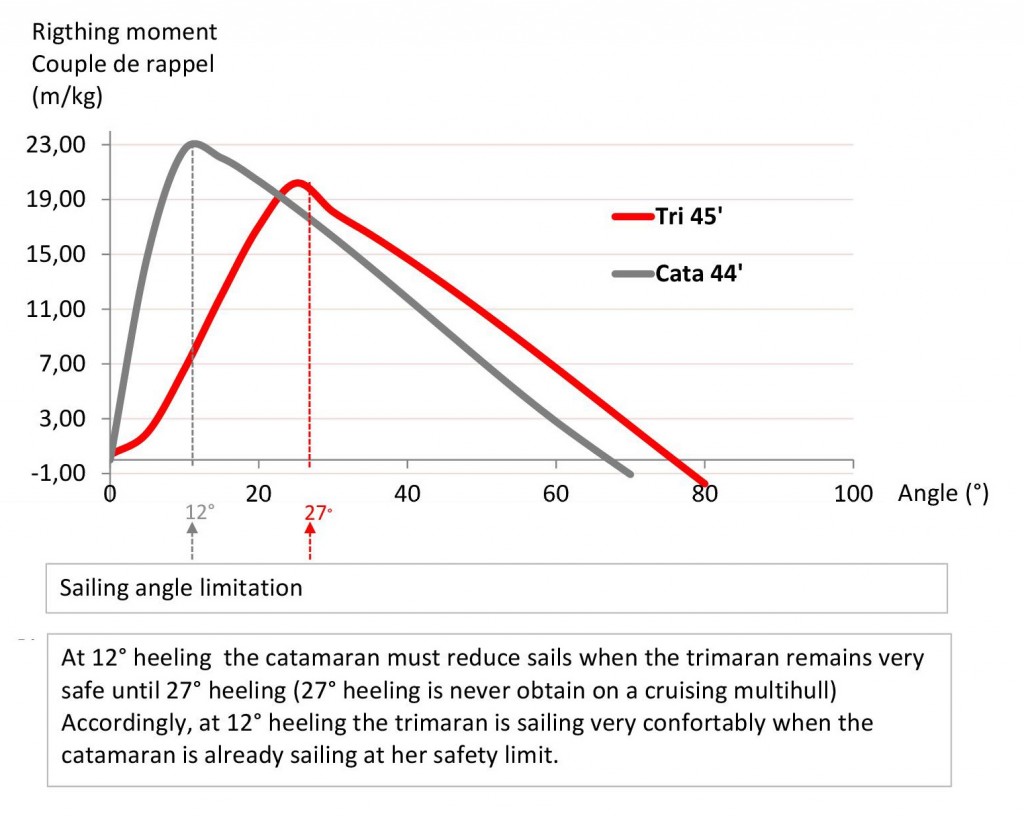
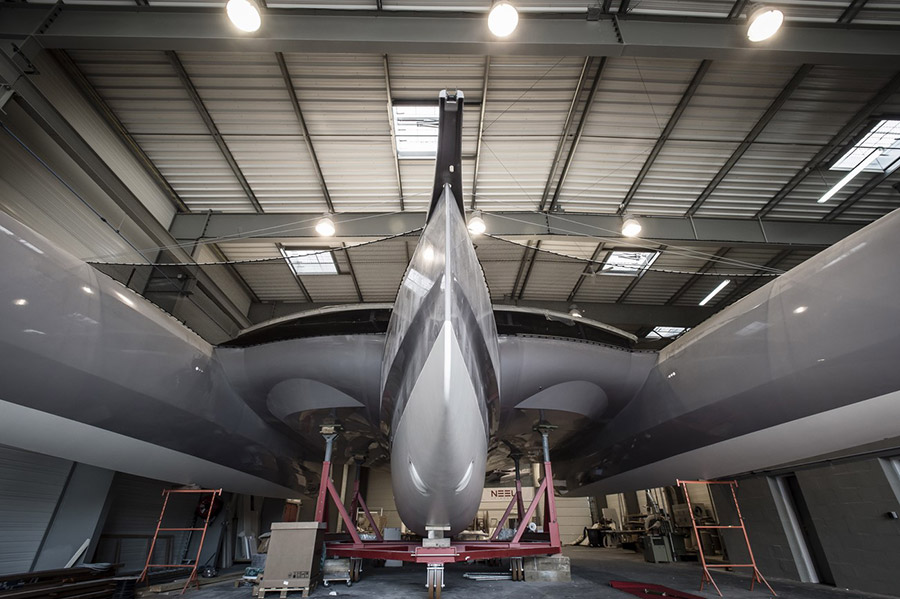
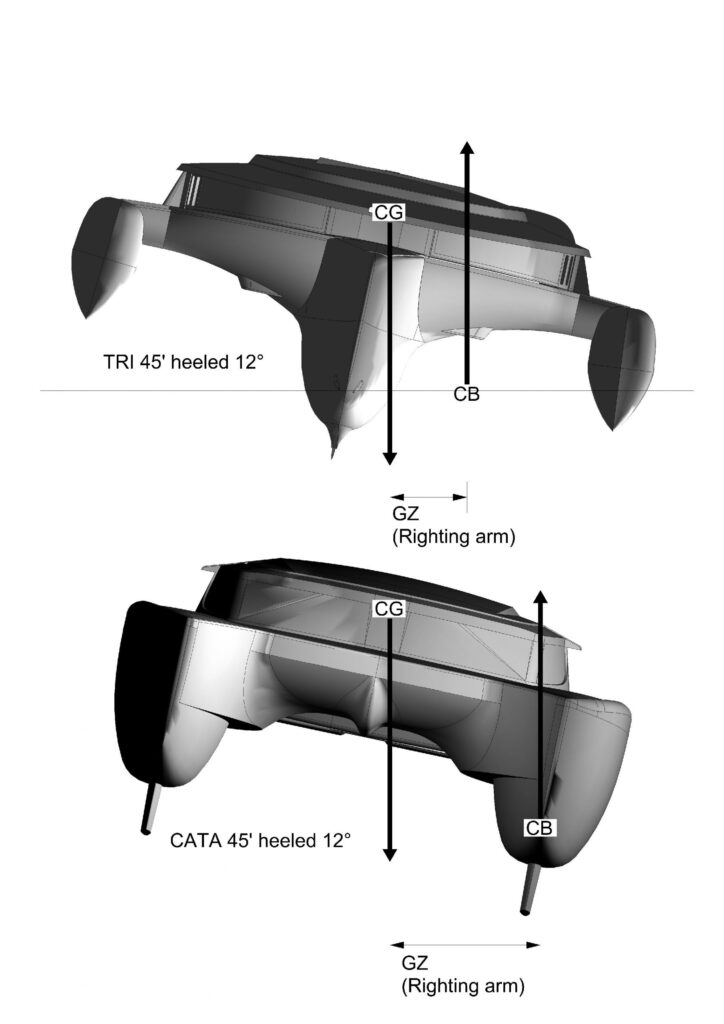
Quality
Innovation
A new aesthetic in naval architecture
The trimarans NEEL are completely liberated from the development pattern of existing cruising trimarans. NEEL has created a new aesthetic in naval architecture.
The NEEL innovation is the integration of the two outriggers with the connecting platform into a unified living space which includes the bridge, a central galley, and a magnificent panoramic lounge. The proportions of the trimaran offer a generous roof area, guaranteeing internal volume.
The entire volume of the central hull is devoted to systems – the engine, electronics, electrical wiring and plumbing, diesel and water tanks as well as long-term supplies storage. The large space available in the lazarette and the high headroom ensure easy access for maintenance of equipment and easy optional installation of generators, desalinators or air conditioning.
The furniture comes in a choice of several contemporary materials. The floors are covered with ultra-resistant high-tech woven polyester which comes in a wide range of colours.
Engine room and storage capacity
Major technical equipment (engine, batteries, generator, etc…) is particularly well protected from water and salt. However, they remain very accessible for maintenance and servicing. Many large indoor and outdoor chests are dedicated to storage and stowage.
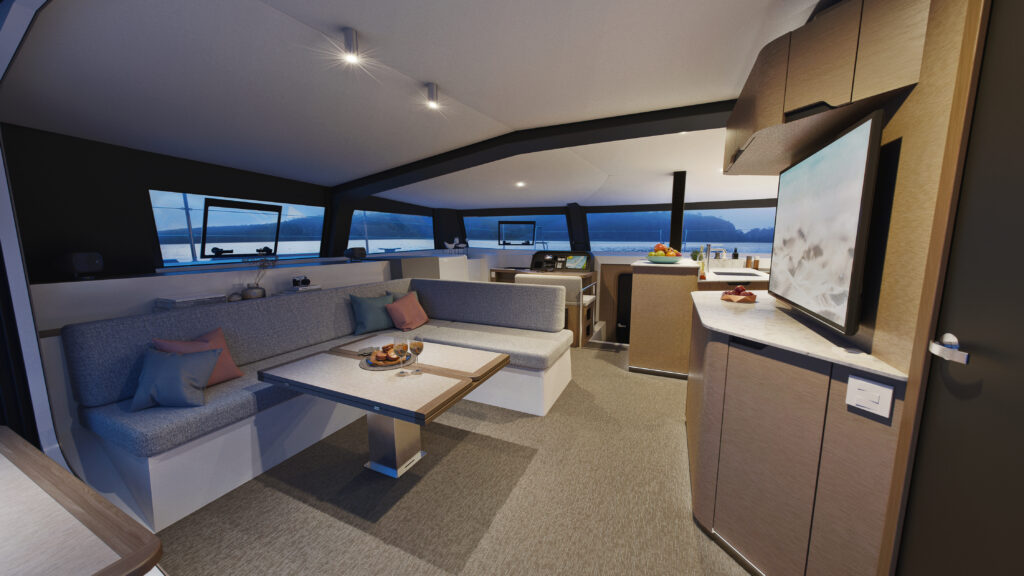

Performance

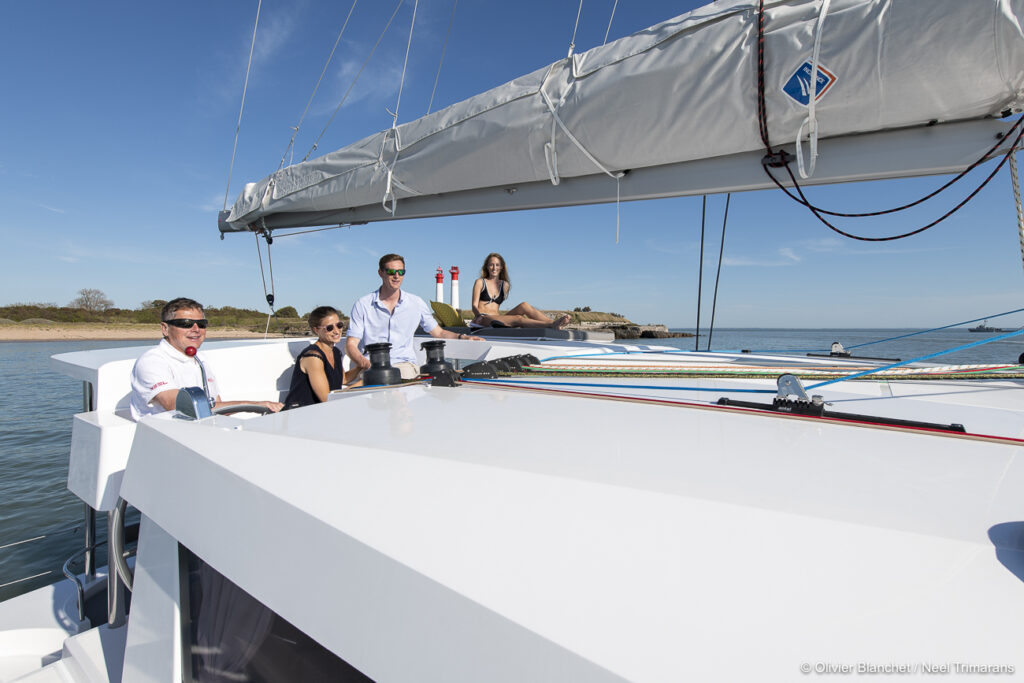
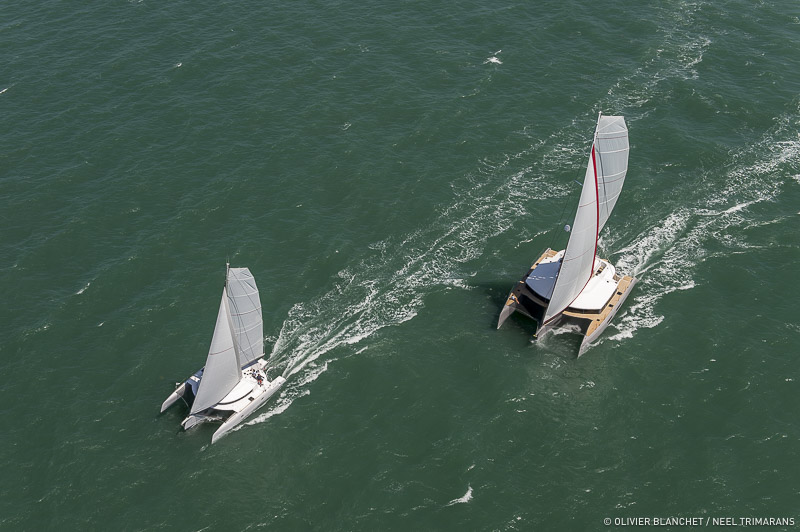
The trimaran NEEL is faster than catamaran:
As shown in offshore racing, the trimaran is significantly faster than monohulls or catamarans. This is also true for cruising trimarans, as proven by the last ARC rally won by a NEEL 47.
The superiority of the trimaran is even more obvious when sailing upwind, especially due to the rig:
- On a catamaran, the forestay pulls from the front beam, the mast compresses a central beam and the shrouds pull the two floats supporting the forestay and mast beam: this platform deforms in many directions. Consequently, it is then impossible to have a rigid forestay
- On a trimaran, the forestay, mast and mainsail tension are structurally bonded to one strong, longitudinal beam : the main hull.
This configuration, as per a monohull, allows for a rigid forestay and good performance up-wind.
Performance is also enhanced by the centered weight.
The extra speed of the trimaran is an additional safety factor.
Steering finesse
The finesse of the steering is a feature highly appreciated by owners of NEEL-TRIMARANS, especially those who have previous experience on high-performance monohulls. This feeling at the helm is a combination of several factors:
- A single wheel steering system connected to a single rudder by spectra lines.
- The most direct line path possible to optimize the sensations at the helm.
- The rudder stock on self-aligning bearings
- A deep rudder under the central hull contributes to the anti-drift surface and allows an efficient tacking.
NEEL trimarans are conceived for fast cruising
With an average cruising speed of around 10 knots, over 200 nautical miles are easily achievable each 24 hours. Speeds from 15 to 18 knots are often reached when the breeze freshens.
Weight centering is managed in order to limit pitching. The centre hull is rockered to facilitate tacking.
Floats are of a stretched form to privilege directional stability and advancement of the centre of buoyancy as a function of sail loading. The rigging is directly derived from racing trimarans, thereby achieving full cruising speeds up to twice as fast as conventional cruising yachts.
The sail surface area is generous with some 17m2 per tonne.
Finally, the trimaran configuration also facilitates sustained speed under motor propulsion. The low prismatic coefficient of the central hull means drag is very weak. The side floats are only very lightly in contact with the surface of the water.
Construction
An in-depth study
To optimise the structure of NEEL-TRIMARANS, we collaborated with TENSYL with whom we have previously worked on the structure of the racing trimaran TRILOGIC.
TENSYL has made a speciality of the structural design of multi hull racing and cruising composites. Sampling is determined from the most critical cases of offshore loading on the structure, for example catching a wave at high-speed or sailing with the wind on the beam.
The analysis programs transmit relevant information which are compared to nominal values in the specs. Colour displays are particularly instructive in sample determination. The overall research programme aims to define type and quantity of construction materials best suited to each zone in order to eliminate unnecessary weight and apply suitable safety margins to load bearing elements.
Optimized construction
NEEL trimarans are manufactured with materials and techniques best suited to their use, combining strength, rigidity and weight reduction.
- Hull, floats, bridges and roof are made in vacuum bonded PVC/foam and glass fibre/ isophthalic polyester resin sandwich structural material.
- The boards are fabricated from honeycomb PVC vacuum bonded with glass fibre/isophthalic polyester resin structural material.
- Resin is infused through Fibreglass according to a sampling plan determined by finite element structural analysis gained from our experience in the construction of racing craft and offshore cruising. Depending on their role in the structure of the trimaran, the type and number of glass fibers are either unidirectional, bidirectional, 0 ° / 90 ° or bi-directional 45 ° / 45 °, Quadri-directional, TAFTA, roving or twill.
- Phonic and thermal insulation, along with floatation (unsinkability) are provided by the interior of PVC foam sandwich laminates. This closed-cell foam is perfect for the marine environment being virtually insensitive to moisture.
- Rigging and sails are designed and produced by multi hull specialists in La Rochelle.
- Interior coverings (linings, floor, upholstery) have all been tested rigorously in oceanic conditions before being selected for your NEEL-TRIMARANS.
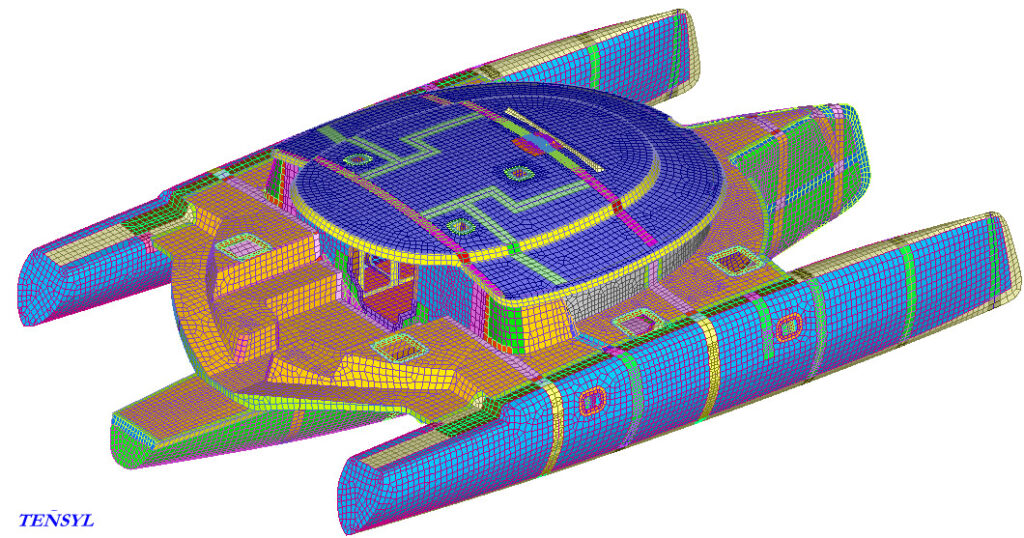
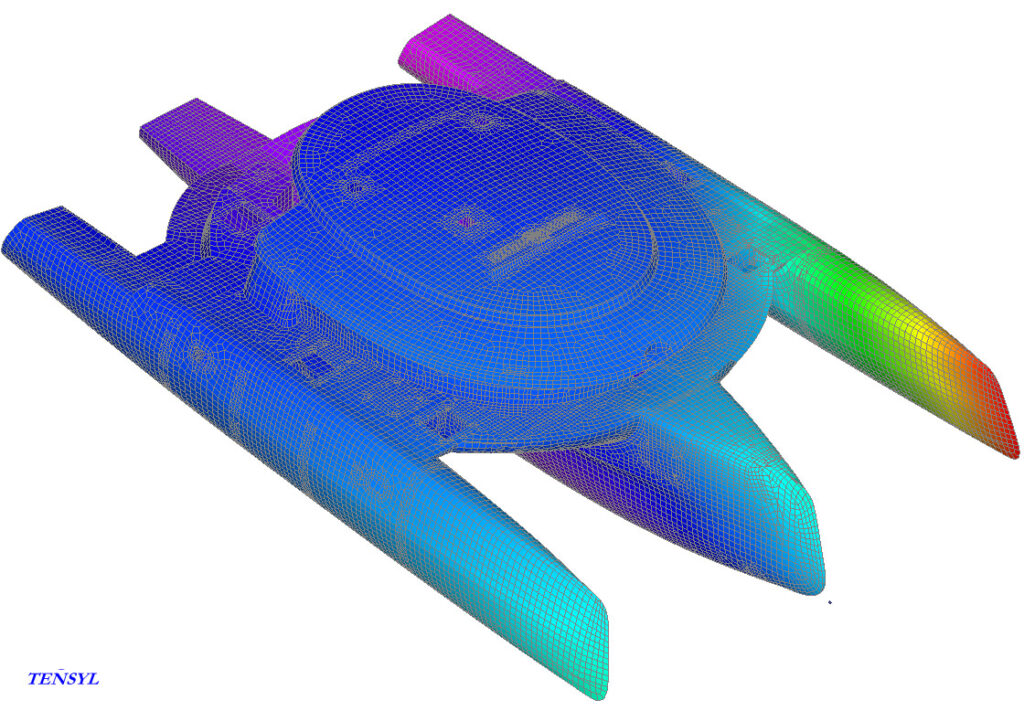

Comfort
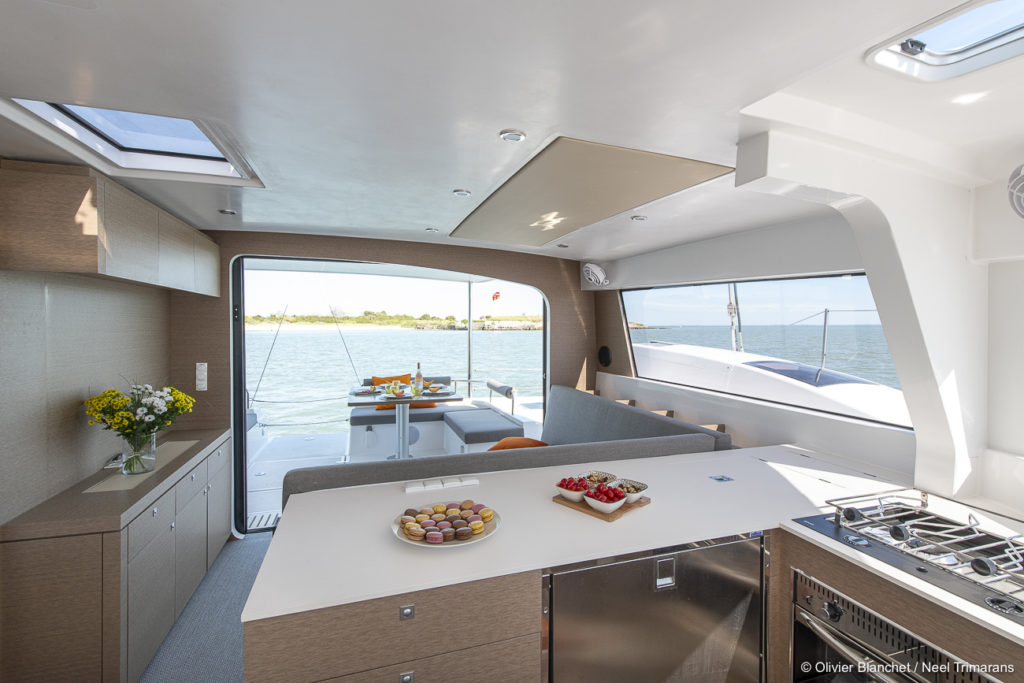

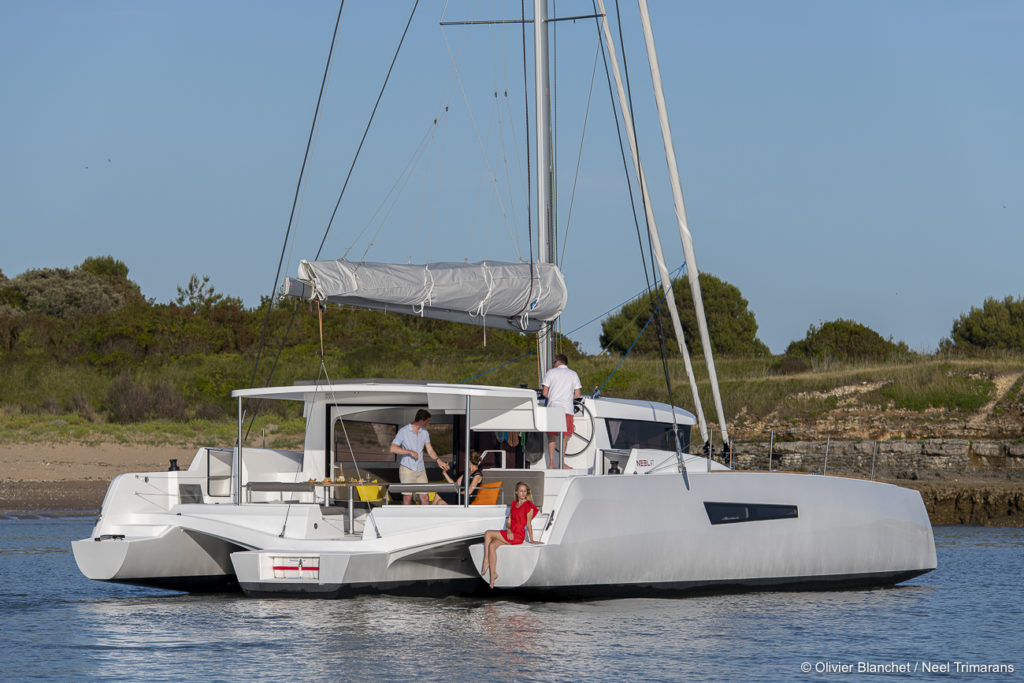
Fun sailing
The trimaran’s very favourable weight/power ratio makes it possible to sail from the first few breezes. The leeward float participates in the anti-drift plane and allows for efficient close-hauled edges. The trimaran sails comfortably thanks to its low angle of heel.
Exceptional hability
The trimaran’s living space is impressive. Indeed the 3 hulls allow an unequalled habitability and original layouts, favouring well-being on board:
- A unique main deck owner’s cabin with an exceptional view of the outside.
- Surprising floats by their volume and aesthetics, a string of privatized living spaces allowing maximum privacy and comfort.
- Numerous and voluminous storage spaces: wardrobes, cupboards, hold and storage compartment.
Cockloon®
The Cockloon® by NEEL-TRIMARANS is an open style layout created by mergering the cockpit and the saloon. Glass sliding doors seamlessely integrate the indoor and outdoor spaces resulting in a particularly impressive living area with an unbeatable view. The interior seating area, coffe table and storage unit create a veritable living room.
The wide sliding glass door can be utilized to modify the layout of the space according to the weather and personal taste. In the fully-open position the doors stows away completly to starboard, thus creating the fabulous Cockloon® effect.
Upholstery made from 100% polyester fabric, specifically designed for both indoor and outdoor use, in particulary soft and pleasant to touch.
At anchor / in harbours
The trimaran’s central hull, perfectly aligned with the mooring line, contributes to the stability and comfort at the anchor, and avoids the sway that catamarans can suffer from. The trimarans are perfectly autonomous thanks to many energy solutions offered in the catalogue, solar panels, watermaker, etc….
The dinghys are generously sized to ensure passenger transfers and facilitate provisioning.
Harbour manoeuvering are facilitated by the engine and bow thruster.
JUST MAKES SENSE

NEEL 47
The NEEL 47 successfully combines the benefits of cruising or blue wateryacht : safety, performance and comfort living.
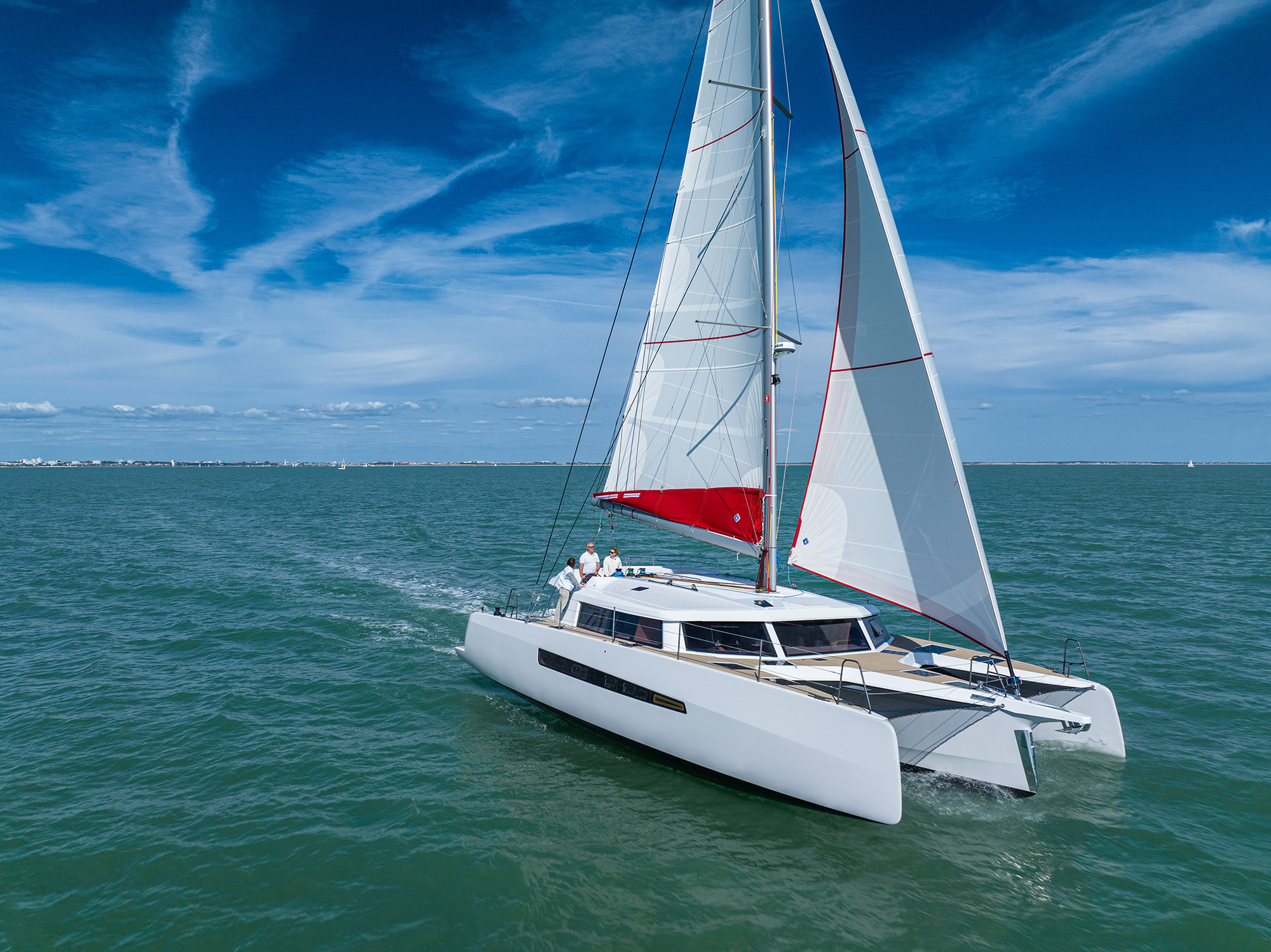
NEEL 52
With its racy, modern silhouette, elaborately designed hull andsleek lines, the NEEL 52 exudes power, speed, and elegance.Moving inside and on the deck is smooth and safe.
